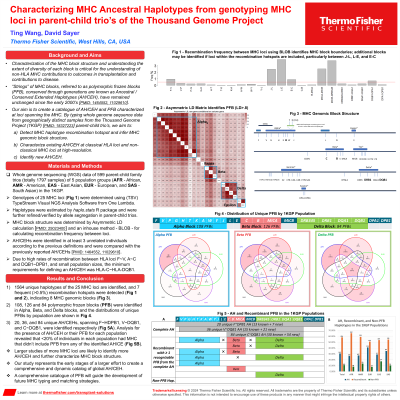Back

(P201) Characterizing MHC Ancestral Haplotypes from genotyping MHC loci in parent-child trio’s of the Thousand Genome Project
Location: Platinum Ballroom

Poster Presenter(s)
Aim: Conserved population MHC haplotypes - ancestral haplotypes/conserved extended haplotypes (AH/CEH) - were first described in the 1990’s. In the absence of significant updates, the genetic content characterizing the genomic blocks (GB) of the AH/CEH largely remains restricted to low-resolution typing of classical HLA genes. By typing whole genome sequence data from geographically distinct samples from Thousand Genome Project (1KGP) parent/child trio’s we aim to: 1) Characterize currently described AH/CEH at classical HLA loci and non-classical MHC loci at high-resolution. 2) Identify new AH/CEH.
Method: We performed genotyping of 25 MHC loci (HLA-F, -V, -P, -G, -H, -T, -K, -A, -W, -Y, -J, -L, -E, -C, -B, MICA, MICB, HLA-DRB345, -DRB1, -DQA1, -DQB1, -DPA1, and -DPB1) on whole genome sequencing data of 599 family trios (totally 1797 samples) in the 1000 Genome Project for their HLA genotypes at 4th-field resolution for the Class I, 3rd-field resolution for the Class II, and 2nd-field resolution for MICA and MICB genes using the TypeStream Visual NGS Analysis Software (TSV) from One Lambda - a Thermo Fisher Scientific brand. Haplotypes were identified using haplo.stats R package and confirmed by segregation in the parent/child trio’s.
Results: Preliminary analysis identified 1483 unique haplotypes of the above 25 loci. Acknowledging higher recombination rates between HLA-A and HLA-C and between HLA-DQB1 and HLA-DPA1, we identified 1045 unique haplotypes across the region HLA-C to HLA-DQB1 to determine 104 AHs according to previous definitions. 18 of the 104 AHs are consistent with previously described AH/CEH, 23 of them are putative novel AH/CEH, and the remainder are either novel or recombinant AH/CEH. Through the population study, we identified 32, 10, 7, 1, and 7 AHs that were unique in the African, American, East Asian, European, and South Asian populations respectively.
Conclusion: Our study represents the early stages of a larger effort to create a comprehensive and dynamic catalog of global AH/CEH which will serve as a critical resource for researchers studying the MHC in disease, transplantation, and anthropology.
Method: We performed genotyping of 25 MHC loci (HLA-F, -V, -P, -G, -H, -T, -K, -A, -W, -Y, -J, -L, -E, -C, -B, MICA, MICB, HLA-DRB345, -DRB1, -DQA1, -DQB1, -DPA1, and -DPB1) on whole genome sequencing data of 599 family trios (totally 1797 samples) in the 1000 Genome Project for their HLA genotypes at 4th-field resolution for the Class I, 3rd-field resolution for the Class II, and 2nd-field resolution for MICA and MICB genes using the TypeStream Visual NGS Analysis Software (TSV) from One Lambda - a Thermo Fisher Scientific brand. Haplotypes were identified using haplo.stats R package and confirmed by segregation in the parent/child trio’s.
Results: Preliminary analysis identified 1483 unique haplotypes of the above 25 loci. Acknowledging higher recombination rates between HLA-A and HLA-C and between HLA-DQB1 and HLA-DPA1, we identified 1045 unique haplotypes across the region HLA-C to HLA-DQB1 to determine 104 AHs according to previous definitions. 18 of the 104 AHs are consistent with previously described AH/CEH, 23 of them are putative novel AH/CEH, and the remainder are either novel or recombinant AH/CEH. Through the population study, we identified 32, 10, 7, 1, and 7 AHs that were unique in the African, American, East Asian, European, and South Asian populations respectively.
Conclusion: Our study represents the early stages of a larger effort to create a comprehensive and dynamic catalog of global AH/CEH which will serve as a critical resource for researchers studying the MHC in disease, transplantation, and anthropology.

